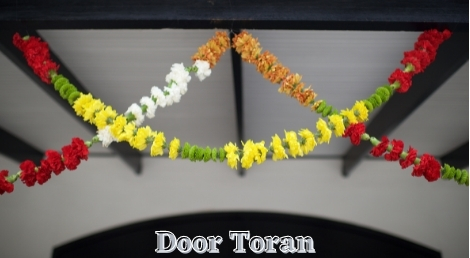Door Toran
Know About Door Toran
Torans, also known as bandarwal, are decorative articles that hung outside the main door frame of a temple, residence, or marriage hall, among other places. Torans are manufactured from a variety of materials and come in a variety of styles. Bandarwar, an age-old kind of door hanging torans, is made of natural and fresh flowers and foliage. These modest torans are in high demand all year and are frequently used to decorate the temple entrances. The door hanging torans are utilised even during the festival seasons and on auspicious occasions such as weddings, poojas, and baby showers.
The way toran/bandarwal are created today has changed dramatically as a result of changing times and inventions. The door bandarwals or wall hanging torans that are currently available on the market come in a variety of materials, patterns, and stunning designs. These torans not only add to the visual value of a Vastu, but they also provide a number of advantages. Every Hindu custom has a deep meaning and brings about a positive transformation in a person's life. Do you know why a toran is tied outside a temple, house, or workplace, or on any other Vastu entrance? If not, let us investigate why toran is tied to the door.
Why Are Torans Hanging Outside Homes?
In many cultures, the entrance of a Vastu is significant. The entrance is thought to be the dividing line between the outside world and the mixed energy it contains, and the interiors of the house and the good energies of Vastu. The door bandarwal enters the picture at this point. The door torans are important in harmonising the house's energy. Aside from being attractive and colourful, door bandarwal provides a number of benefits and contributes to the development of a happy atmosphere in the area. The bad energy, pollutants, and dangerous microorganisms present in the air are absorbed by Indian toran, which are formed of fresh flowers and leaves. One of the most intriguing aspects of the designer torans is how they look whimsical whether hanging on a Vastu door or in the connecting passageways that connect rooms.
Fresh mango leaves and flowers attract deity principles, particularly those of Goddess Lakshmi, and bring prosperity and wealth into the home. It also contributes to the dissemination of tranquilly in the home, business, and the Vastu they are hung in, making the environment more pleasant. The colour combination of the artificial flower door toran or the plastic flower toran, or any of the wall hanging toran and the plain toran, plays an important function. For example, the green colour helps to soothe the agitated mind and provides respite from tension and anxiety. Similarly, orange colour of the marigold flower repels negative energy, while the yellow colour attracts prosperity and Chaitanya.
History of Bandarwal
The name "Toran" comes from the Sanskrit word "Torana," which means "to pass." The 'Torana' in Buddhist architecture referred to the wood or stone bars that consisted of two standing bars on which cross-projecting sections of bars rested. In Buddhist architecture, this structure was known as the 'Torana,' which meant ‘sacred entryway.' The two vertical standing pillars, as well as the cross-piece projecting pillars, were wonderfully sculpted with diverse designs and patterns, most of which related a tale or contained carvings of figurines that play an important part in Buddhism. These pillars served as the primary entrance to a sacred site.
The first trace of Toran dates from the Maurya dynasty in the 3rd century BCE. During this time, the Sanchi Stupa was constructed. Similarly, the Torana can be found in a variety of temples constructed at various times. The Torana can still be seen today in temples such as the Rajarani temple, Jagannath temple, and Mukteswar temple. Thus, torans are one of the most important aspects of Hindu culture, which can be seen in both ancient Holy Scriptures and olden architecture.
The ancient torans differ significantly from the torans or bandarwals that we use today.
Uses And Benefits Of Torans
Torans be it fancy or decorative, they can be used for hanging at the door of various vastus. Let us look at some of the uses of bandarwals.
· It can be hung on the temple's main entry door.
· It can be utilised to hang on the Vastu's main entrance.
· It can be utilised to hang at the office door's entrance.
· The torans are also hung on the venue doors of an auditorium, business venue, marriage hall, and other places for special occasions.
· In Puranas, information on torans may be found. Let us have a look at the advantages that torans provide when they are draped outside of dwellings.
· The traditional Indian toran, which hangs on the entryway, helps to invite and attract Goddess Lakshmi's heavenly principles.
· It aids in the removal of negativity from the home/Vastu.
· Positive energy is attracted to it. The toran's different colours provide colour therapy and aid in mind relaxation.
· Aids in the reduction of stress and anxiety.
· Aids in attracting wealth.
· Traditional Indian torans, which are woven from fresh flowers and leaves, aid in the prevention of sickness.
· Defends against the evil eye.
· Chaitanya and happiness are spread.
Thus, torans not only add beauty to the main entrance of the house but also help in attracting positive energies in the house. Torans holds a rich history. Let us delve deep into the origin of bandarwal or door torans.
Beautiful Door Toran Designs
The Door Torans are available in a variety of designs and patterns. Also, the materials with which these torans are manufactured differ. Given below are some of the various Torans available:
· Traditional Bandarwar
· Floral Bandarwar
· Rudraksha Toran
· Pearl Bandarwar
· Glass work Toran
· Cloth toran
· Rudraksha and gemstone Toran
· Shubh Labh Velvet cloth Bandarwar
· Ganesh Rudraksha Bandarwar
· Fancy toran
· Designer toran
· Wall hanging toran
· Artificial flower door toran
Thus, the torans play a significant role in the Hindu culture and has been used since Puranic period to decorate and welcome Goddess Lakshmi in the homes.
-
Talk to Astrologer On Call
Starting from 12 per minute only
-
Get Detailed Manual Report
Starting from 250 only
-
Read Article
Read Astrology Articles
- Vedic Astrology,...
- Exp - 12 Years
- English, Hindi
- K.P. Astrology, V...
- Exp - 25 Years
- English, Hindi
- Vedic Astrology
- Exp - 25 Years
- English, Hindi



